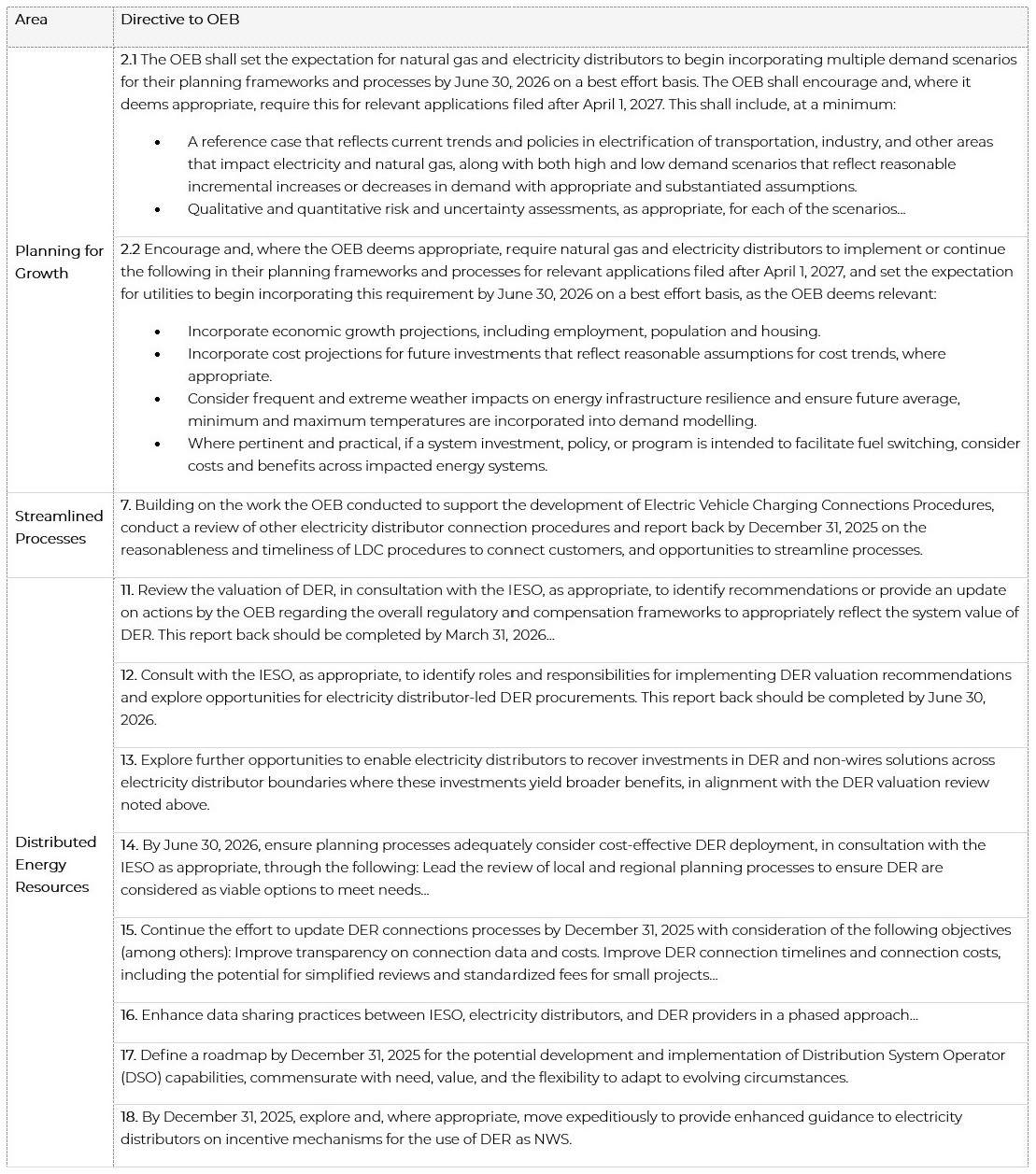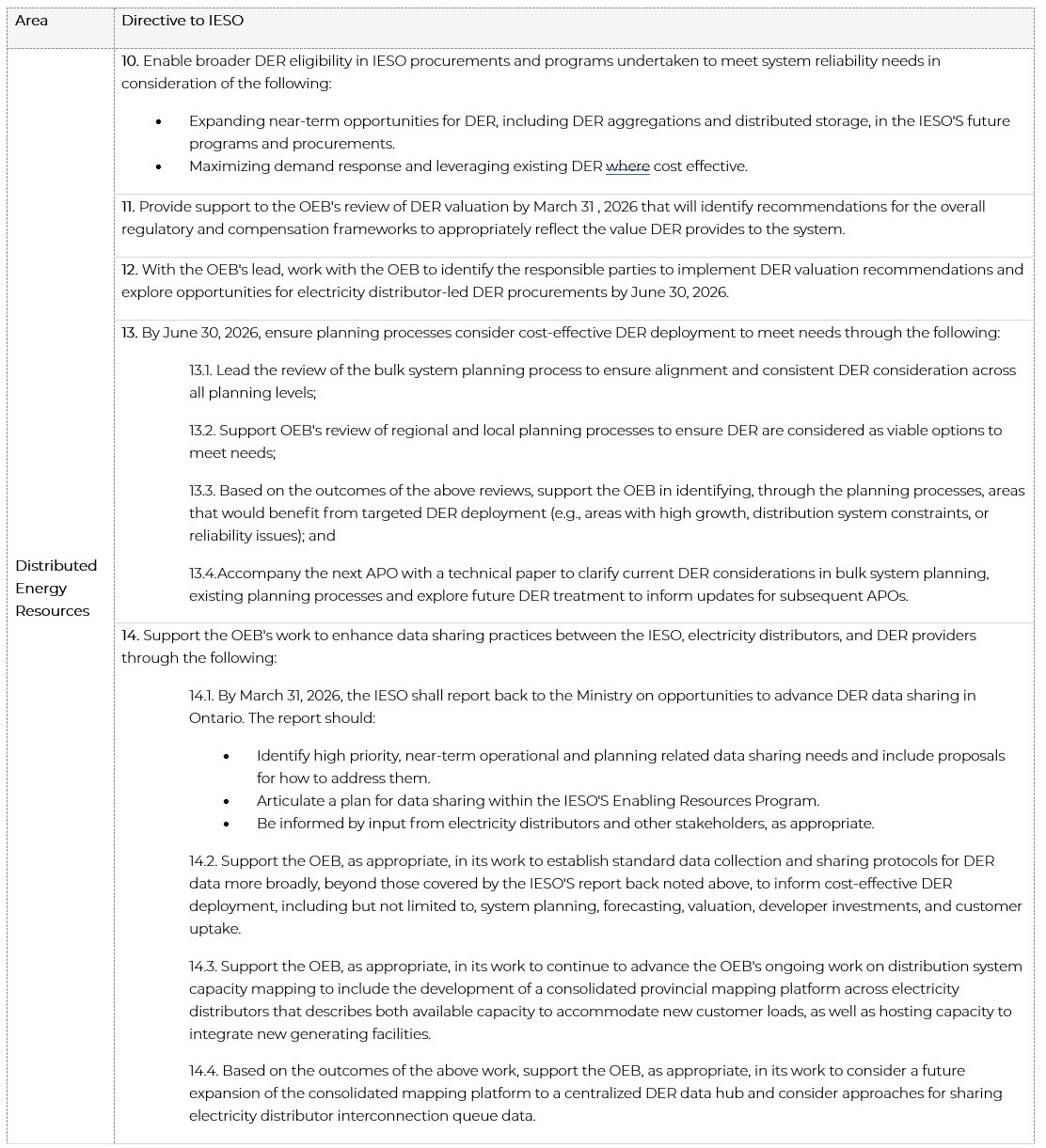Ontario’s June 2025 Integrated Energy Plan (IEP) Energy for Generations (see Commentary), builds extensively on the ideas laid out in the government’s 2024 energy policy vision document, Ontario’s Affordable Energy Future: The Pressing Case for More Power (Ontario’s Affordable Energy Future, see Commentary). Chapter 4 of the IEP focusses on role of the distribution sector and distributed energy resources (DERs), delivering greater clarity on several policy issues.
Further, the IEP implementation directives to the Ontario Energy Board (OEB) and Independent Electricity System Operator (IESO) contain many items on (1) new planning expectations for electricity distributors, and (2) facilitating DER participation in Ontario’s electricity system.
“Defining electricity distribution grid modernization”
The IEP fulfills the pledge made in Ontario’s Affordable Energy Future, which stated “Ontario recognizes the need to work with theOEBto provide greater clarity and predictability toLDCsso that they can modernize their infrastructure to provide the energy and services that ratepayers need into the future.”
Specifically, the IEP provides a definition of grid modernization: “The paced, prudent, and cost-effective use of technologies and solutions that improve the efficiency, resilience, reliability, and capacity of electricity distribution systems. The purposes of said investments are twofold: to lower long-term costs for ratepayers and to better manage the availability of electricity to meet growing demand.”
The IEP also sets out a series of outcomes that grid modernization should enable, including minimizing services interruptions, operational efficiency, cybersecurity, increased flexibility, better management of DERs, and empowering customers.
“Strengthen Reliability and Resilience”
Noting the importance of local electricity networks for critical infrastructure such as food security, transportation, and telecommunications, the IEP states that the government “will establish an Energy Resilience Advisory Group to identify opportunities and co-benefits of planning across these systems to protect Ontarians in the most effective and cost-efficient manner from extreme weather disruptions and to build layers of resilience in case critical infrastructure gets disrupted.”
“Enabling Growth Through Faster, Streamlined Connections”
The IEP states that the province “is developing new regulations to reduce the upfront capital costs associated with connecting to distribution and transmission infrastructure, including for residential developments and industrial customers.” Through connection cost responsibility reform, the government wants a framework that does “not unduly burden first movers and discourage prudent, proactive investment in electricity infrastructure to meet broader provincial policy goals such as the construction of new homes, businesses and other priorities.”
“Unlocking the value of distributed energy resources”
With respect to DERs, the IEP states that “the full value of these resources remains largely untapped. Customers have limited options to be compensated for the benefits their DER provide to the grid, and many projects face barriers to participation. There is significant opportunity to guide DER investment to where it is most cost-effective and beneficial to local and system-wide needs.” Further, the government notes that it will introduce a DER strategy aimed at: (1) strengthening grid resilience and efficiency, (2) empowering consumers, and (3) attracting investment and unlocking innovation.
As part of its plan to expand DER opportunities, the IEP states the government is “[r]eviewing the net metering framework to better reflect the system value of customer-sited DER and to expand eligibility,” as well as “[e]xploring new cost-recovery models for DER investments by the OEB to allow electricity distributors to recover costs across a broader area when the benefits of DER extend beyond a single project or community.”
The IEP states the government will be taking measures to better ensure that DERs are integrated into system planning through:
OEB and IESO Directives
The government’s IEP implementation directives to the OEB and IESO include detailed individual directives elaborating on the points made above. A non-exhaustive list of the directives to the OEB and IESO relevant to electricity distributors and DERs are set out in the tables below.




Commentary
Overall, the IEP appears to be creating significant investment opportunities for electricity distributors, customers and DER providers.
Prior to the IEP, Ontario’s planning and policy direction has focussed mainly on the transmission network and transmission-connected supply resources. However, building upon policy direction found in Ontario’s Affordable Energy Future, the IEP (and its directives) reflects the government’s growing recognition of the distribution sector’s critical role in meeting future electricity demand and supply needs. Ontario is forecast to require up to 75% more electricity by 2050 with most of this new demand connected to the distribution system. Further, an increasing amount of supply resources will also be connecting to the distribution system during this time.
While the exact timing and rate of demand growth, new load, fuel-switching, and DER penetration is uncertain, this outlook requires significant infrastructure investment in the distribution system. The IEP makes this point strongly:
“As electricity demand grows, driven by new housing, industrial expansion, and the electrification of vehicles and heating. LDCs are being asked to do more than ever before.
“To meet these growing demands,LDCswill need to strengthen their infrastructure, adopt new technologies, and deliver services more efficiently and affordably. This includes making significant capital investments in substations, transformers, and digital grid management tools.” (emphasis added)
These investment expectations represent a significant change from the relative steady-state, low demand growth environment of the past 20 years. Building in anticipation of new load (housing and business), electrification via fuel-switching, and more DERs require a new proactive approach to planning and investment by electricity distributors.
Moreover, the government’s clear expectation of anticipatory investment requires evolution of the OEB’s approaches to ratemaking (e.g., the current performance-based approach to rate regulation, Incremental Capital Module, and potentially new mechanisms), evaluating rate applications, costs allocation and recovering, performance measurement, etc. For example, a more proactive approach to distribution infrastructure investment (including grid modernization) will require the OEB to assess how costs can and should be allocated efficiently and fairly between existing and future customers. The OEB will need to provide clarity on how it will consider (and how it wants electricity distributors to consider) the costs and benefits of investments made to facilitate fuel-switching, including the impacts on customers’ total energy bill rather than exclusively focussing on electricity distribution costs. Guidance and/or consultation will be required regarding how the OEB will (1) examine options for electricity distributors to potentially socialize the costs of DER and NWS investments beyond their own service territories, and (2) incorporate its new objective “to support economic growth” (as proposed in Bill 40, Protect Ontario by Securing Affordable Energy for Generations Act, 2025). Some of the approaches discussed above will likely require additional direction from the government to the OEB.
With respect to DERs specifically, it appears there will be ample opportunities over the coming months for interested parties to provide input into OEB and/or IESO processes related to DER valuation, compensation, integration into planning, streamlining connections, and enabling broader procurements and programs. For example, ongoing consultations currently include the OEB’s DSO initiative, the IESO’s Local Generation Program, and the IESO’s HVAC DR Program as part of the Electricity Demand Side Management (eDSM) Framework.
While the IESO’s statutory mandate extends beyond the traditional functions of a wholesale market operator, recent government direction appears to further expand its role in enabling DERs. This expansion is occurring even as the government increasingly acknowledges the critical importance of the distribution system and the evolving role of LDCs. Rather than clarifying and strengthening the mandate of LDCs, the government has assigned many DER-related responsibilities to the IESO. Power Advisory is concerned that this could lead to inefficiencies stemming from misaligned roles, limited coordination, and a lack of clear accountability for DER integration at the distribution level. Without more deliberate engagement and direct participation of LDCs and a clear articulation of their mandate, Ontario risks missing opportunities for timely, cost-effective, locally optimized solutions.
Conclusion
Ontario is embarking on a significant expansion of the province’s electricity network. The IEP (and its directives) provides strong signals that the government acknowledges that a critical aspect of this undertaking involves the need for electricity distributors to expand their networks in advance of expected future growth (load and supply).
Further, the province has recognized the need to provide better incentives and greater opportunities to those seeking to invest in DERs (customers, project developers, aggregators) and has tasked the OEB and IESO with developing and enabling options. This work should also include a review of the roles and responsibilities of the IESO and electricity distributors with respect to DER programs and procurements with the objective of reflecting the changing nature of the electricity system (i.e., increasing importance of distribution and DERs) with tasks assigned to the entity best able to manage those roles and responsibilities. The increasing decentralization of supply resources and increasing customer participation appears to favour refocussing the IESO on its core responsibilities of wholesale market administration, planning, procuring, and operating the bulk-system while reallocating responsibilities to electricity distributors for planning, procuring, and managing DERs (and eDSM).
Stakeholders need to be ready to react nimbly in this challenging environment featuring a dynamic, quickly evolving regulatory and policy landscape, touching virtually every aspect of the electricity (and energy) sector, including the roles and responsibilities of the government, OEB, IESO, and regulated utilities, connection processes, cost-allocation, cost-recovery, adjudication of rate applications, compensation frameworks, procurements and programs, bulk-system to local planning, modelling and forecasting, and innovation funding.
An apt expression for these times is Fortuna Eruditis Favet: "Fortune favours the prepared mind."
Please contact Power Advisoryif you have any questions or would like any additional information.